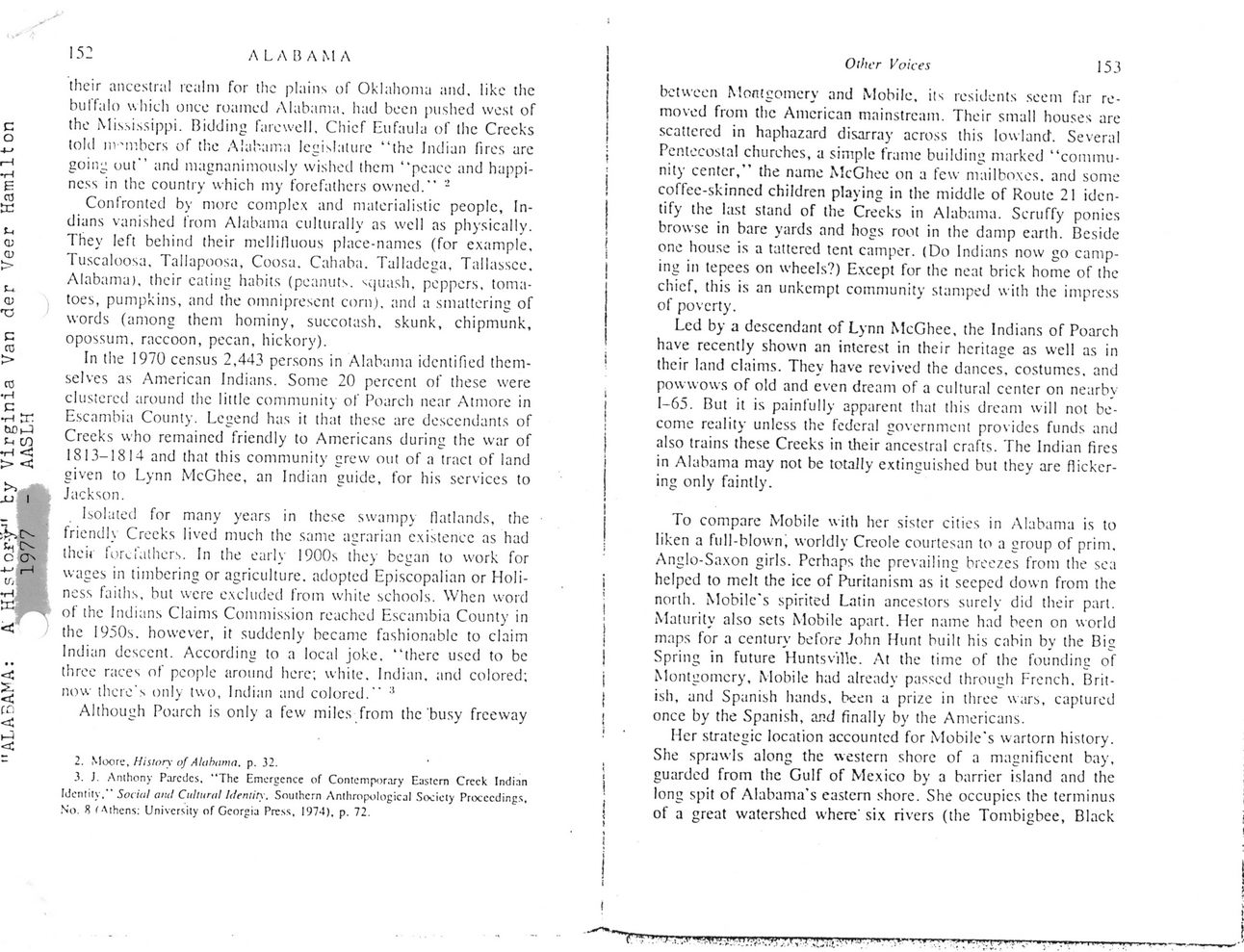This text was obtained via automated optical character recognition.
It has not been edited and may therefore contain several errors.
ALABAMA: A ftistoi?-jr" by Virginia Van der Veer Hamilton V?? 1977 - AASLH 152 ALABAMA their ancestral realm for the plains of Oklahoma and, like the buffalo which once roamed Alabama, had been pushed west of the Mississippi. Bidding farewell, Chief Eufaula of the Creeks told members of the Alabama legislature ?the Indian fires are going out? and magnanimously wished them ?peace and happiness in the country which my forefathers owned.? Confronted by more complex and materialistic people, Indians vanished from Alabama culturally as well as physically. They left behind their mellifluous place-names (for example. Tuscaloosa, Tallapoosa, Coosa. Cahaba. Talladega, Tallassce. Alabama), their eating habits (peanuts, squash, peppers, tomatoes, pumpkins, and the omnipresent corn), and a smattering of words (among them hominy, succotash, skunk, chipmunk, opossum, raccoon, pecan, hickory). In the 1970 census 2,443 persons in Alabama identified themselves as American Indians. Some 20 percent of these were clustered around the little community of Poarch near Atmore in Escambia County. Legend has it that these are descendants of Creeks who remained friendly to Americans during the war of 1813-1814 and that this community grew out of a tract of land given to Lynn McGhee, an Indian guide, for his services to Jackson. Isolated for many years in these swampy flatlands, the friendly Creeks lived much the same agrarian existence as had their forefathers. In the early 1900s they began to work for wages in timbering or agriculture, adopted Episcopalian or Holiness faiths, but were excluded from white schools. When word of the Indians Claims Commission reached Escambia County in the 1950s. however, it suddenly became fashionable to claim Indian descent. According to a local joke, ?there used to be three races of people around here; white, Indian, and colored; now there's only two, Indian and colored.? 3 Although Poarch is only a few miles from the'busy freeway 2. Moore, History of Alabama, p. 32. 3. J. Anthony Paredes, ?The Emergence of Contemporary Eastern Creek Indian Identity,*? Social and Cultural Identity . Southern Anthropological Socicty Proceedings, No. 8 (Athens: University of Georgia Press, 1974), p. 72. Other Voices 153 between Montgomery and Mobile, its residents seem far removed from the American mainstream. Their small houses are scattered in haphazard disarray across this lowland. Several Pentecostal churches, a simple frame building marked ?community center,? the name McGhee on a few mailboxes, and some coffee-skinned children playing in the middle of Route 21 identify the last stand of the Creeks in Alabama. Scruffy ponies browse in bare yards and hogs root in the damp earth. Beside one house is a tattered tent camper. (Do Indians now go camping in tepees on wheels?) Except for the neat brick home of the chief, this is an unkempt community stamped with the impress of poverty. Led by a descendant of Lynn McGhee, the Indians of Poarch have recently shown an interest in their heritage as well as in their land claims. They have revived the dances, costumes, and powwows of old and even dream of a cultural center on nearby 1-65. But it is painfully apparent that this dream will not become reality unless the federal government provides funds and also trains these Creeks in their ancestral crafts. The Indian fires in Alabama may not be totally extinguished but they are flickering only faintly. To compare Mobile with her sister cities in Alabama is to liken a full-blown^ worldly Creole courtesan to a group of prim, Anglo-Saxon girls. Perhaps the prevailing breezes from the sea helped to melt the ice of Puritanism as it seeped down from the north. Mobile's spirited Latin ancestors surely did their part. Maturity also sets Mobile apart. Her name had been on world maps for a century before John Hunt built his cabin by the Big Spring in future Huntsville. At the time of the founding of Montgomery, Mobile had already passed through French, British, and Spanish hands, been a prize in three wars, captured once by the Spanish, and finally by the Americans. Her strategic location accounted for Mobile's wartorn history. She sprawls along the western shore of a magnificent bay, guarded from the Gulf of Mexico by a barrier island and the long spit of Alabama?s eastern shore. She occupies the terminus of a great watershed where' six rivers (the Tombigbee, Black

Alabama History-Book-Excerpt-01